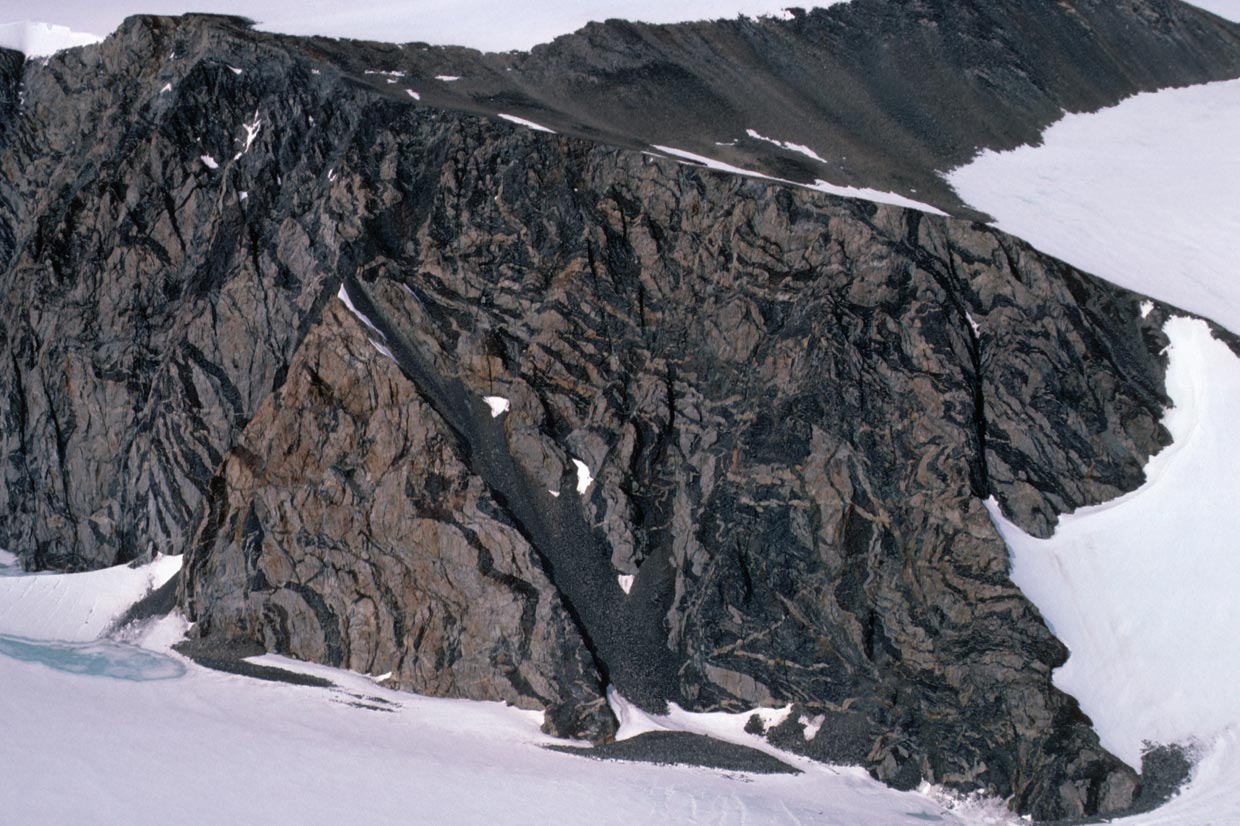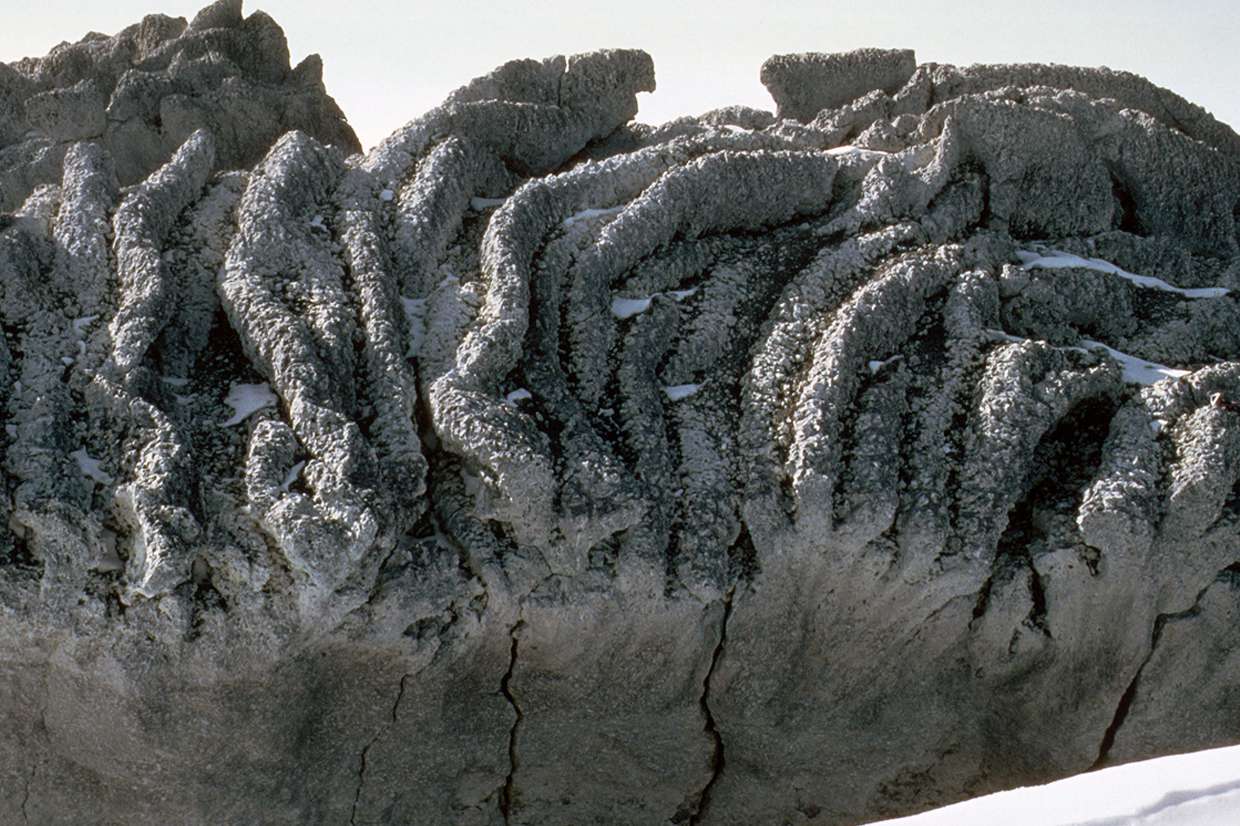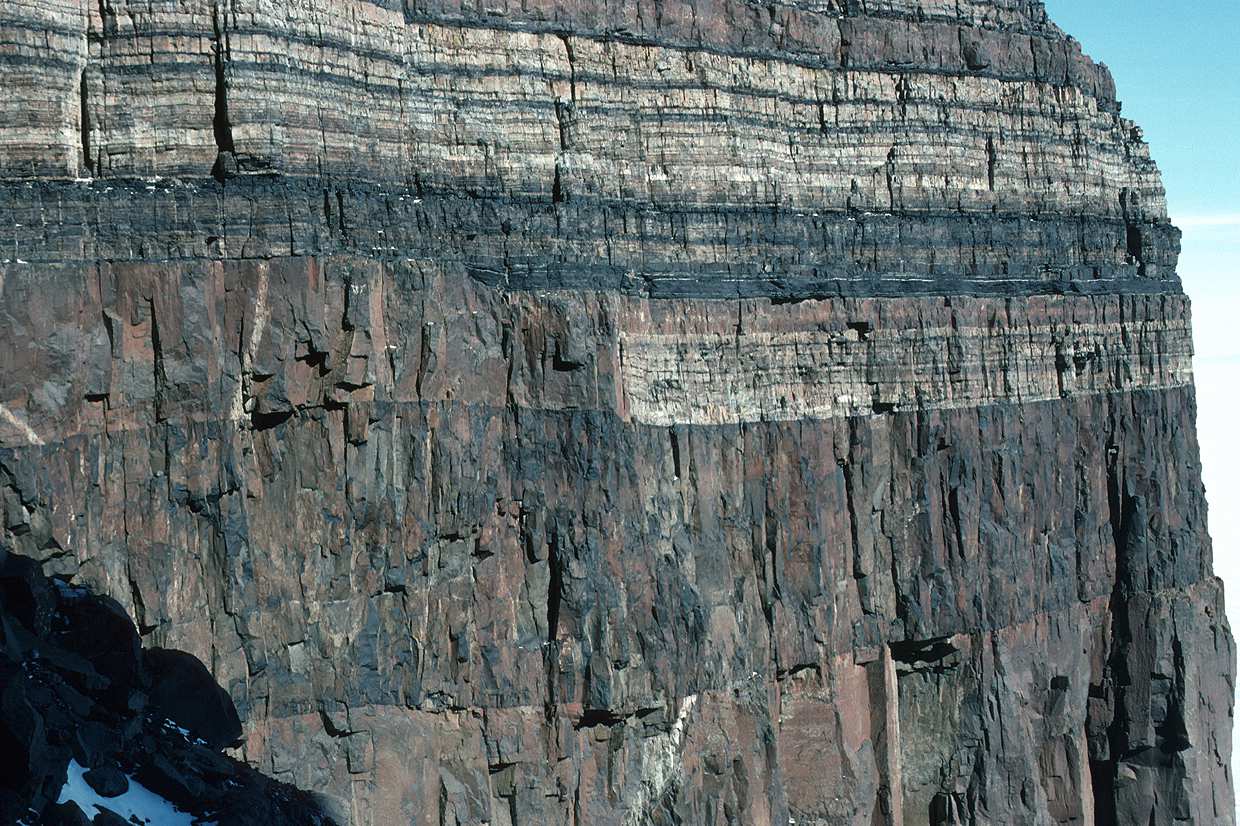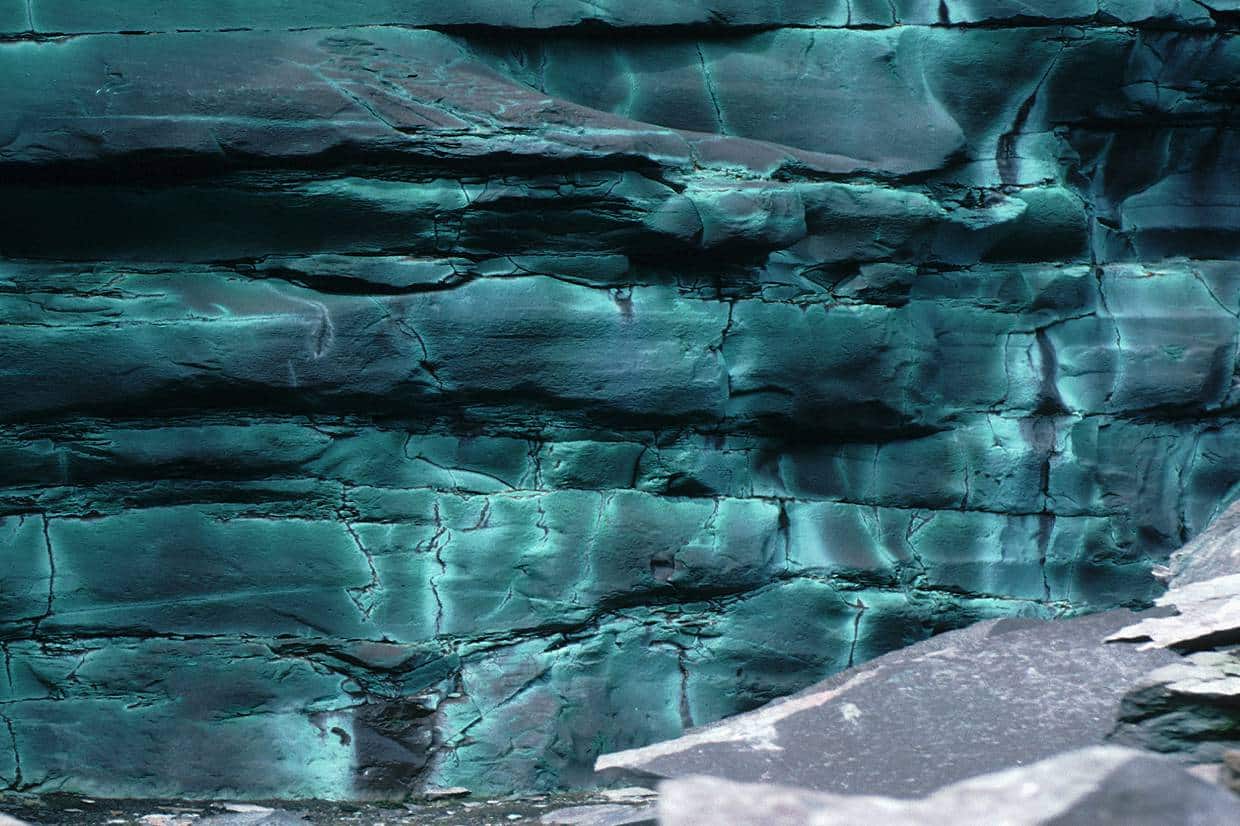
Antarctica’s geology
What kind of rocks make up Antarctica? What geological processes are occurring today? What rock and mineral resources exist there?
Warm up
The geology of Antarctica
Antarctica’s geology is highly varied. This is unsurprising considering the size of the continent and the changing tectonic processes, environments, and climates that it has experienced over geological time. However, because over 99% of the continent is covered in ice, Antarctica’s geology is not known in detail, and our understanding of the rocks and geological structures beneath the ice must be inferred from the limited area of rock (roughly 0.4% of the continent) that is exposed at the surface as well as from remote sensing technologies. These include satellite imagery, ground penetrating radar, the use of seismic waves, and the study of gravity anomalies. While many maps of Antarctica’s geology have been drawn at various scales, there is currently an effort to increase the detail of coverage and to make geological maps available digitally.
Study of Antarctica’s geology has led to many important insights: some rocks preserve evidence of times that were warmer as well as providing clues for scientists to reconstruct when and how the supercontinent Gondwana broke apart (as described in the previous section). While there has been a great deal of volcanic activity in Antarctica’s past, there are still some areas of volcanism in the continent today.
Antarctica is not without rock and mineral resources, however, for physical and political reasons (see below) these are not exploited at the present time.
Intriguingly, Antarctica is the best place in the world for finding meteorites. So not only is the continent an important place to study Earth’s geological history – it is also a window to the geology of the solar system.

Cold facts
The differences of East and West Antarctica
(million year = myr)
East and West Antarctica are quite distinct from each other in terms of their geology. East Antarctica is much larger and is an area of continental shield (or ‘craton’) composed of ancient igneous and metamorphic rocks, some exceeding 3 billion years in age. Overlying the ancient continental shield rock in various places are younger sedimentary rocks (e.g. sandstones, limestones, shales, and coal) which formed at different times under different environmental conditions. For example, coal beds exposed in the Transantarctic Mountains formed through the accumulation of plant matter during the Permian Period (290 to 245 myr ago) when the continent had a warm temperate climate. Over millions of years this organic material was buried; and by compaction under the weight of overlying sediment, it was eventually turned into coal.
Around the margins of the East Antarctic continental shield there are areas of basalt rock which formed through the solidification of basaltic lava during the break up of Gondwana. As the southern continents separated, volcanic activity associated with rifting caused extensive flood basalts: great quantities of lava emerged from fissure eruptions at various times and spread over the land to form successive layers of basalt rock. (Where magma was unable to reach the surface, igneous intrusions occurred to create sills and dykes within pre-existing rock formations.) By study of these areas of basalt, geologists have been able to identify the most active areas of rifting in the past as well as to work out the timing of separation between the different continental areas. For example, basalt from Antarctica that is identical to basalt from South Africa indicates a shared ‘volcanic province’. Radiometric dating of these volcanic rocks shows that they began forming around 180 myr ago indicating that these two continents began to break away from each other during the Jurassic Period.
The geology of West Antarctica has much in common with the geology of the Andes. In fact, this side of Antarctica owes its origin to the same mountain building processes that uplifted the western side of South America. During the early Jurassic (around 200 myr ago) oceanic crust began to subduct beneath the Pacific margin of Gondwana. The resulting subduction zone extended along the margin of what is now South America and West Antarctica. Volcanism above the subduction zone created new land adjoining the Gondwana margin that eventually became the Antarctic Peninsula (a continental margin arc). Subduction, volcanism, and uplift of this region occurred almost continuously until about 35 myr ago and ceased when the Antarctic Peninsula and South America finally separated to create the Southern Ocean.
Unlike East Antarctica, West Antarctica is made up of a number of relatively small plate fragments that have been merged together along the south-eastern Pacific compressional plate boundary. As compression took place, pre-existing rocks were folded, faulted and uplifted – spectacularly so in some places as seen in the Ellsworth Mountains which contain Antarctica’s highest peak (Mount Vinson).
The Transantarctic Mountains however, owe their origin to rifting rather than crustal compression and collision. From the Late Cretaceous Period onwards, there has been uplift and rifting between West and East Antarctica along what is known as the West Antarctic Rift. In places, this rift system is still active today and is the cause of present-day volcanic activity in Antarctica. The continent’s most active volcano, Mount Erebus, is located along this rift system, on Ross Island at the edge of the Ross Sea. It is one of the few volcanoes in the world to have an open, convecting lava lake within the crater at its summit. There are also several inactive volcanoes in the Transantarctic Mountains.
Read more about Antarctica’s volcanoes:
British Antarctic Survey: Volcanoes in Antarctica
USGS: Antarctica Volcanoes and Volcanics


Mineral Resources
Mineral resources contained in Antarctica include coal, especially in the Transantarctic Mountains; and iron, copper and nickel ore in the Prince Charles Mountains (near Mackenzie Bay, East Antarctica). However, these are not believed to be present in quantities to rival other continents, and their extraction and transport would be expensive. The same is true for the petroleum that is believed to be held in rocks beneath the Ross and Weddell Seas. In any case, commercial mining is unlikely for the foreseeable future because the 1998 Environmental Protocol to the Antarctic Treaty put a ban on mining subject to review in 2048.
There are some special circumstances that make Antarctica the best place to find meteorites: more have been collected from Antarctica than from the rest of the world put together! In most other land areas meteorites are difficult to find because they may become covered in vegetation, soil or sediment; and over time they are subject to weathering processes that alter them both physically and chemically. The situation in Antarctica is different and can be summarised as follows:
- Some meteorites fall on the ice sheet and become buried and encased in glacier ice.
- Due to the subzero temperature, physical and chemical weathering processes are negligible, and meteorites remain unaltered for long periods of time.
- Meteorites are carried in the flow of the ice and are concentrated in areas where the ice meets a mountain barrier (especially in places where the East Antarctic Ice Sheet flows towards the Transantarctic Mountains).
- Eventually meteorites emerge at the surface along mountain fronts where overlying ice is removed by wind erosion and sublimation.
- In these ‘blue ice’ areas where meteorites concentrate, their dark colour makes them easy to spot.
Since 1969, over 10 000 meteorites have been collected from Antarctica. These objects from space have yielded important information about the nature of asteroids and their composition. It has also been discovered that some of the meteorites are actually bits of the Moon and Mars that must have been ejected into space during the distant past at times when large asteroids collided with these bodies.
Read more about the main mineral resources of Antarctica (including issues surrounding their exploitation) by downloading the word document: Under Pressure: metals, minerals and meteorites.


Student activity
You are now a scientist who is required to write a brief one-page fact file on Mount Erebus for Antarctic scientists to take on their field season.
You are required to make this fact file fun but informative but must include the following:
- Its location: Where is it, what are the latitude and longitude? How close is it to mainland of Antarctica?
- What are the main causes of its volcanic activity (e.g. what is its tectonic setting?)
- When was the latest eruption?
- Are there any other cool facts that you can find out about Mount Erebus?
Use the following links to help you:






